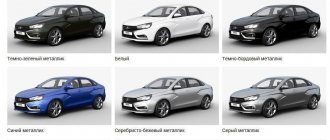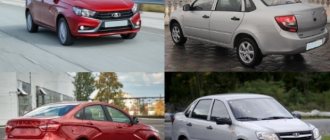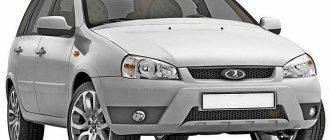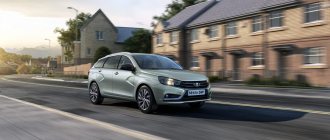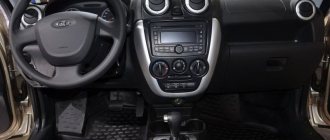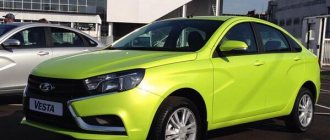April 24, 2020 Lada.Online 6 880 9
The group “Lada Vesta - Pros and Cons” compared the configurations of Lada Vesta at the time it entered the market and the versions currently being produced. All differences were published in the form of a list, which was divided into “improvements” and “cheaper”.
Vesta and Doctor X
Representatives of AvtoVAZ, who arrived for our Vesta crash test, respectfully called this gray-haired German “Doctor” - as is customary in Germany to address people with an academic degree. Before moving to Tolyatti in February last year, the Doctor held a high position in the development department of a very serious German concern.
And, probably, his obligations to this company implied a “non-disclosure agreement” even after the end of the contract. Otherwise, why would the VAZ people insist that we not mention the Doctor’s name and not publish photographs? So let’s just call him Doctor X.
The task before him was not an easy one: to bring the passive safety of Vesta to three stars in the Euro NCAP rating and to four “our” ARCAP stars. Happened?
- Ernst Glas? Of course I know him,” Doctor X was not embarrassed by my question.
Let me remind you that it was Ernst Glas who was sent from Wolfsburg to our crash test of the Volkswagen Polo (AR No. 23, 2010). The German sedan then earned 14.3 points out of 16 possible and the maximum four ARCAP stars - the best result in the entire history of Autoreview crash tests.
True, we had to deviate from our rules and buy a car for 570 thousand rubles in the Comfort configuration with two airbags: the basic Classic versions with one driver’s airbag were simply not on sale at that time.
But while we were asking the engineers how to correctly disable the passenger airbag, VAZ decided that the “basic” Vesta would also have two airbags.
What was the real reason? The desire of buyers, as the VAZ directorate claims, market conditions (this is the version of the PR department) - or did Tolyatti decide at all costs to get a high result in our ARCAP rating? After all, the cheat sheet for sellers sent to dealers in November indicated that Vesta with one pillow scores three ARCAP stars, and with two, four.
And this is just one of the mini-detectives related to the passive safety of the new VAZ model.
Another example.
Ten years ago, the very first prototype of Project C (many developments on it formed the basis of Vesta) immediately scored 13 points out of 16 possible for a frontal strike according to the Euro NCAP method (AR No. 12, 2006).
And a year ago, some VAZ workers answered the question “How’s Vesta?” They answered: “No way. Recently they hit it and it fell apart. The bosses said they wouldn’t let Vesta and I work, they would take us to Spain.”
Maybe that’s also why these engineers no longer work at VAZ?
In addition to Tolyatti, work on the rigidity of the cabin “cage” and the energy-absorbing properties of the side members was carried out at the research centers IDIADA (Spain) and UTAC (France).
Engine
Lada Vesta can be equipped with three different engines:
- 1.6 l 16-valve 129 engine with 106 hp. With.
- Reworked Priorovsky 98 l. With. 1.8 l also 16-valve 122 l. With. 179 engine, has variable valve timing on the camshaft.
- 1.8 liters per 145 liters. s., has greater boost compared to the previous engine, the shape of the camshaft has been changed.
Judging by practice, 1.8 liter engines consume more oil compared to 1.6 liter engines.
Crash test Lada Vesta - Leading auto portal
The safety of a car is determined by the so-called crash test. Leaders of the global automotive industry test cars in accordance with EuroNCAP requirements. The winners in their class, taking first place in the ranking, receive five stars.
| SUV | Price |
| XRAY | from 619,900 rub. |
| 4×4 Urban | from 629,900 rub. |
| 4×4 Urban 5 doors | from 672,900 rub. |
| 4×4 | from 553,900 rub. |
| 4x4 5 doors | from 596,900 rub. |
| 4x4 Bronto | from 742,900 rub. |
| Crossover | Price |
| XRAY Cross | from 767,900 rub. |
| Sedan | Price |
| Vesta | from 629,900 rub. |
| Granta | from 455,900 rub. |
| Granta Sport | from 554,900 rub. |
| Priora | from 424,900 rub. |
| Vesta Cross | from 776,900 rub. |
| Vesta Sport | from 1,042,900 rub. |
| Granta Drive Active | from 640,900 rub. |
| Station wagon | Price |
| Kalina Station Wagon | from 475,200 rub. |
| Largus | from 615,900 rub. |
| Largus Cross | from 775,900 rub. |
| Priora Station Wagon | from 443,000 rub. |
| Vesta SW | from 706,900 rub. |
| Vesta SW Cross | from 813,900 rub. |
| Granta Station Wagon | from 482,900 rub. |
| Granta Cross | from 574,900 rub. |
| Van | Price |
| Largus Van | from 589,900 rub. |
| Hatchback | Price |
| Granta Liftback | from 472,900 rub. |
| Kalina | from 460,600 rub. |
| Kalina Sport | from 576,900 rub. |
| Kalina Cross | from 545,800 rub. |
| Priora Hatchback | from 443,000 rub. |
| Granta Hatchback | from 472,900 rub. |
Gearbox from Hyundai and Lada
The Lada Vesta's AMT transmission is really quite good. For its class, this automatic transmission is very good. Yes, during acceleration there are sometimes dips in traction, but they are not very noticeable. Be that as it may, you can get used to the box of the Lada Vesta very quickly.
Sometimes, of course, you need to get used to it. The start from a standstill is absent-minded, the car rushes with some pauses, the car is often switched to low and acceleration begins. In modern automotive industry, cars are made in which the gearbox itself adapts to the driver. The domestic car has not yet evolved before this, so it is the driver who has to adapt to the Lada Vesta. But, once you get used to the box (it’s not that difficult), you can safely drive without any problems or twitches. The box is quite excellent and very good for this segment.
Recommended article: Comparative review of Lada Vesta vs Lada Granta
Yes, it is worth admitting that the gearbox in the Hyundai Solaris is better. The transmission is precise and almost never jerks the car. Solaris picks up speed faster and smoother. Sometimes, of course, there are problems with choosing a reduced speed, but this happens quite rarely.
It is worth admitting that the Koreans have made the gearbox better, however, the modern motorist will hardly feel the difference, because the “jambs” of the Vesta gearbox can sometimes be very difficult to notice. In addition, to buy an automatic transmission for the Lada Vesta, you will have to pay only 25 thousand rubles. And this suggests that this automatic transmission is made from the cheapest parts available on the automotive market. The Solaris box is also not expensive - only 40 thousand rubles, but the difference of 15 thousand makes you think twice.
Noise insulation and sounds inside the cabin
As for sound insulation, everything is sad for a domestic car. Inside the cabin you can hear the engine grunting, the wind whistling, etc. In general, there are extraneous noises and they are sometimes very annoying. It is worth admitting that the sound insulation of the Lada Vesta is much better than that of VAZ’s predecessors, but still. Sitting in the cabin of a Hyundai Solaris, you will not hear such extraneous noise. However, there is one weak point - the noise of the wheels is heard, which sometimes becomes very boring and wildly annoying. Perhaps the noise of the wheels is boring due to the fact that Korean engineers have worked hard on soundproofing other loud parts, but it’s still much better than sitting in a Lada and hearing absolutely all the sounds of the car.
Recommended article: Niva Pickup (VAZ 2329) can even cope with Russian off-road conditions
If you look at quality subjectively, then Solaris is a level better than Vesta. This applies to almost all sounds. Starting from opening and closing the door and ending with extraneous noise while driving.
What did you find out?
If you look at the optimal level of equipment we have set, the picture is as follows: Lada Vesta is the cheapest (692,000 rubles), then comes Volkswagen Polo (809,900 rubles), then Hyundai Solaris (843,000 rubles), followed by Skoda Rapid (RUB 849,000), and the KIA Rio (RUB 854,900) completes the list.
But don't rush to conclusions! This is just the beginning of the search for the best option. Upon closer examination, it turns out that the factory configurations are designed in such a way that you can get a lot of unnecessary “load” and you cannot discard non-essential equipment without compromising key items in the equipment list. Sometimes it is better to pay a little extra, and sometimes this is not worth doing under any circumstances.
Lada Vesta. Version 1.6 5AMT Comfort (RUB 692,900) is cheaper than competitors’ analogues, and you can’t call it “naked”. For example, in addition to the “optimal minimum” we have chosen, there is already a stability control system, traction control, engine protection, height adjustment of the driver’s seat, rear parking sensors and cruise control.
However, it can be improved. Firstly, the buyer can order the Multimedia package for 28,000 rubles. Instead of a “junior” audio system with a 4.3-inch monochrome display, you get a 7-inch touch screen with navigation, support for USB, SD, AUX and Bluetooth, six speakers and a rear view camera.
However, a logical question arises: is this option worth the money? The answer is negative. If only because navigation is available in any modern smartphone, and if necessary, you can install a non-original camera (displaying an image on a non-standard interior mirror) - together with work, everything will cost less than 10,000 rubles.
Version 1.8 5AMT Comfort with the Image package for 750,900 rubles also doesn’t look very logical. Yes, there's an extra 16 hp here. power, there are three-level heated front seats, a heated windshield and 16-inch alloy wheels. But are you ready to pay an additional 58,000 rubles for all this? We are not sure…
If you pay extra, then pay in full! And here the Lada Vesta in the Luxe configuration with the Multimedia package is of interest. Such a car costs 783,900 rubles - as much as 91,000 more expensive than the Comfort version originally considered! But the list of equipment includes side airbags, seat upholstery in fabric/eco-leather, three-level heated front seats, heated windshield, rain and light sensors, 16-inch wheels and, of course, that same advanced multimedia complex with navigation and rear view camera.
That is, the situation turns out that it is better to either take Vesta with a simpler “robot” in the Comfort version (704,900 rubles), or, on the contrary, much more expensive - in the Luxe Multimedia package (795,900 rubles).
Hyundai Solaris. Here things are different. The most affordable car with a 6-speed automatic transmission costs 843,000 rubles (this is a sedan with a 1.4-liter 100-horsepower engine in the Active Plus version). However, by paying an additional 25,000 rubles, the buyer can get a noticeably faster 1.6-liter engine with 123 hp.
New Lada: Transmission: semi-synthetic or synthetic?
And such an additional payment seems quite justified. The equipment of Solaris in the Active Plus version is no worse than that of the reviewed Vesta, and in some places even better: there is a VSM stabilization system, a tire pressure sensor, and an audio system with steering wheel controls. But if you want to get more, the marketing tricks will begin.
Let's say you prefer not to skimp on safety and want to install additional side airbags. But you can’t order them as a separate option - you need to take the Safety package (40,000 rubles), which is available only in combination with the Winter package (another 40,000 rubles) and only on cars with a 1.6-liter engine in the Comfort version.
That is, you will have to add another 80,000 to the already considerable amount of 898,000 rubles. It’s already not far from a million. This is definitely a good thing for marketers and sales managers. But this amount seems too high to us. But the version with a 1.6-liter engine (for 868,000 rubles) is a more interesting option. And that’s why we consider it optimal. Total - 868,000 rubles. To suit your taste, you can add metallic/pearl color for 6,000 rubles.
KIA Rio is not much different in equipment from Solaris, because technically these are very similar models. Thus, the most affordable sedan in the Comfort configuration with a 1.6-liter 123-horsepower engine and automatic transmission, similar to the Solaris in the Active Plus version, is slightly more expensive - 879,900 rubles versus 868,000.
Otherwise, we repeat, the KIA Rio is almost identical to the Solaris. The car doesn't even require a long description. “Serious” options like side airbags and curtain airbags start here only in the Prestige version (from RUB 1,004,900); they cannot be obtained separately. Therefore, the whole story can be limited only to the words that the Comfort version for 879,900 rubles is optimal.
But the Volkswagen Polo configurations are formed according to a different principle than those of the “Koreans” or Lada. A very different combination of engines and versions is available - for example, a car even with a basic 90-horsepower engine can be ordered with a fairly advanced Joy package. However, we are interested in sedans that are more powerful and have two pedals, so the choice comes down to the Polo with a 1.6-liter 110-horsepower MPI engine and a 6-speed automatic transmission and a 1.4-liter TSI turbo unit combined with a 7-speed DSG robot.
In this case, we recommend choosing the first combination. And it’s not just about the price (the price of a VW Polo with DSG starts from 904,900 rubles). Although the Germans have indeed worked to improve their robotic dual-clutch gearbox, the classic torque converter is still more reliable.
All that remains is to decide on the configuration. If with KIA and Hyundai each step up a step means a significant increase in equipment, and you take “everything at once,” then with Volkswagen the main focus is on equipment packages. Even in the relatively simple version of Trendline (RUB 804,900), Polo will be equipped with everything necessary from the minimum we specified.
New Lada: Life hack: how to remove the glove compartment on a Vesta, eliminating squeaks and rattles
But the stabilization system comes as an option and costs as much as 31,990 rubles. But on Vesta, Rio and Solaris it is already included in the basic equipment! Sounds like “saving on matches” in German! Therefore, the buyer has a choice of two options. If you think that safety is more important to you, then it is best to take the Polo in the Trendline configuration, pay extra for ESP and the Comfort package (RUB 14,990), which includes very practical options - a heated windshield and electrically adjustable and heated side mirrors . To this you will have to add an additional payment of 15,990 rubles for any color except white. In total, we get a sedan that costs 867,800 rubles.
If you consider yourself a careful and experienced driver and are willing to sacrifice ESP, then you should pay attention to the Drive version (the stabilization system is not available with it, but there are other advantages). In combination with a 1.6-liter 110-horsepower engine and a 6-speed automatic transmission, it is 35,000 rubles more expensive than the Trendline version (one step lower), but it already includes such pleasant items as a “sports” steering wheel with leather trim, electrically adjustable and heated mirrors, cruise control, a rear view camera, a multimedia system with a 6.5-inch color touch screen and heated washer nozzles.
In general, the price difference is clearly justified. To this you can add the “Comfort” package (RUB 27,990), which includes climate control instead of air conditioning, parking sensors and a heated windshield. And we must not forget about the cost of painting with metallic enamel (RUB 15,990). In total, the Volkswagen Polo in the Drive version will cost 888,880 rubles - the second best option for this model. Although, frankly speaking, in both cases the choice is somewhat strange: either a good package or ESP - you can’t get it in the Drive version even for an additional payment.
Finally, the most affordable Skoda Rapid with the same 1.6-liter 110-horsepower engine and 6-speed automatic transmission as the Polo is offered in the Active configuration for a minimum of 864,000 rubles. For this money, the car is already equipped with much of what we indicated in the “required minimum”, except for air conditioning and “music”, but it has an ESC stabilization system.
But the missing equipment can be purchased in the form of options: air conditioning - 36,300 rubles (it is better to take a package that, in addition to air conditioning, includes heated mirrors and heated seats. All together - 37,700 rubles). Additional payment for the most primitive “music” (Blues) - 11,700 rubles. It makes more sense to take the Swing audio system for 13,300 rubles. But there are more interesting options...
The next oldest version of Ambition with the same power plant is 113,000 rubles more expensive, and among the fundamentally useful options it differs only in that they do not ask for additional payment for air conditioning and a Swing radio with six speakers, and this package also includes fog lights and mirrors with heating.
New Lada: Better than nothing: we buy a Lada Granta for 250 thousand
All this is clearly not worth the specified amount, so it is much more logical to take a car in the Active configuration, and get the necessary options in packages. First of all, you should pay attention to the Hockey Edition Active package, which costs as much as 48,000 rubles, but includes air conditioning, heated mirrors, heated front seats, Swing radio, rear wiper and some other, less significant options.
The best option in our understanding: Rapid 1.6 AT Active (from RUB 864,000) Hockey Edition Active version (RUB 48,900) engine protection (RUB 6,600) metallic color (RUB 14,900) = RUB 934,400.
So which is more profitable?
A meticulous calculation showed that, all other things being equal, the Lada Vesta (RUB 795,900) is the most profitable, followed by the Volkswagen Polo (RUB 867,800), then the almost identically equipped Hyundai Solaris (RUB 874,000) and KIA Rio (RUB 879). 900 rubles), and the most expensive was the Skoda Rapid (934,400 rubles).
What conclusions can be drawn from this? Firstly, if money plays a fundamental role, then it turns out that Lada Vesta is the best choice. Moreover, in terms of equipment, the Russian car is practically not inferior to its classmates, and the cost of spare parts and maintenance is one of the traditional advantages of AvtoVAZ products. Reliability, build quality and service standards are another issue, because of which, admittedly, many will prefer a foreign car.
The strongest competitors are the KIA Rio and Hyundai Solaris, which are essentially the same model but with different designs. The traditional advantages of the “Koreans” are also known: a fairly extensive list of options included in the price and a five-year warranty. Compared to them, the formally cheaper Volkswagen Polo looks somewhat pale.
And the point is not only that the “German” has to pay extra for each option, which makes the car noticeably more expensive than the initially stated price. The problem is that the VW Polo is already obsolete - with minor updates, the model has been produced since 2020, and it’s even surprising that this sedan is still in the Top 10 best-selling.
Well, at the end of our list is the Skoda Rapid. True, one cannot call her a clear outsider. The thing is that in size it is practically a “golf-class” model (the Rapid is larger in size than the first generation Skoda Octavia!). And if trunk volume and interior dimensions are important, this is the best choice.
Conclusion
If you don’t pay attention to the cost of cars and compare similar configurations, then you have to admit that the Hyundai Solaris looks more dynamic and attractive than its competitor. There is no noise, the car looks more powerful, there are more pleasant little things in the cabin, etc.
But, as soon as it comes to practicality, driving comfort and cross-country ability, then the Russian car becomes the undoubted leader. It is more adaptable to bad roads and is pleasant to sit and drive inside. The suspension is more comfortable, there is more space in the cabin, and passengers have much more space.
You can also read on this topic:
New Renault Duster 2015-2017 - The most complete test drive
UAZ Bukhanka (diesel) – economical SUV
Porsche Macan: photos, specifications and price in Russia
German cars at their best
Tuning VAZ 2114 (tuning Lada 2114) with your own hands, photos to boot
Share on social networks
Dmitry Seregin August 3, 2017
Published in: Korean cars, Russian cars
Tags: Hyundai, AVTOVAZ, In Russia, Korean cars, Korean foreign cars, Our cars, new products, New, Russian cars, sedans
